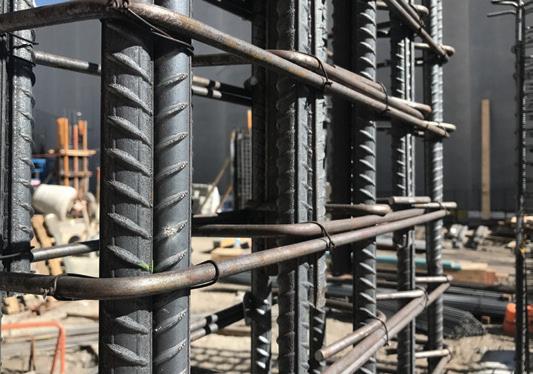
5 minute read
FIBRE OPTIC SENSORS MONITORING BRIDGES AND CRITICAL STRUCTURES
FIBRE OPTIC SENSORS MONITORING BRIDGES AND
CRITICAL STRUCTURES
Advertisement
by Dusan Stojkovic, Senior Project Manager, VicTrack
The way we manage and maintain bridges and other structural assets is set to be revolutionised by the adoption of embedded sensors, system analytics and AI, making asset monitoring more accurate, more efficient and significantly cheaper.
FiBridge – an advanced structural health monitoring (SHM) solution – uses fibre optic sensors to collect and return real-time information about structural health, providing asset owners or operators with a wealth of knowledge to proactively assess asset condition, manage maintenance and optimise operations.
FiBridge grew from a VicTrack innovation project to improve asset monitoring and maintenance. Extensive trials conducted over two years proved FiBridge’s viability as an efficient and accurate asset monitoring system with strong commercialisation potential.
VicTrack owns Victoria’s transport land, assets and infrastructure, including more than 2,500 bridges, on behalf of the State Government.
VicTrack shares responsibility for keeping them all safe with rail operators V/Line and Metro Trains Melbourne (MTM). Our asset management program requires regularly taking stock of the structural health of bridges we manage and performing necessary maintenance. Until now, the only way to do that was periodic inspection by an engineer, usually twice per year – a huge undertaking considering the large number of bridges across the state.
Periodic inspection on such a large scale is expensive, laborious and inefficient. Those aren’t the only problems. Inspections are also prone to human error – some faults are not easily visible to the human eye – and can be disruptive to road and rail users if a bridge has to be closed for inspection.
We have thought for some time that there has to be a better way to monitor the structural health of Victoria’s bridge assets. We believe we’ve found it in FiBridge. HOW FIBRIDGE IS A GAME-CHANGER
FiBridge uses tiny Industrial Internet of Things (IIoT) connected sensors attached to a bridge’s structure. The sensors measure and estimate parameters including structural strain, thermal response, bending moments, shear/impact loads, vibration and corrosion – all indicators of a bridge’s structural health.
Real-time data on the bridge’s performance is sent back to a remote single point for analysis. Bridge owners and operators are able to apply the diagnostic and prognostic information provided though physics-based system analytics and AI to manage assets, gaining efficiency and achieving cost reductions.
RIGOROUS TRIALS
The development of FiBridge kicked off in late 2017, funded by a $500,000 grant from the Victorian Government’s Public Sector Innovation Fund. VicTrack teamed up with Silicon Valley’s Palo Alto Research Center (PARC) – a Xerox Company – and Victorian Government partners including Department of Transport (now incorporating VicRoads and Public Transport Victoria) and Department of Environment, Land, Water and Planning (DELWP) – who manage thousands of bridges between them – Department of Premier and Cabinet, Office of Projects Victoria and education partners to test whether fibre optic sensing technology could be used to develop a costeffective and robust product for monitoring structural health in bridges.
PARC-designed miniature fibre optic sensors were first installed on a major Victorian highway bridge, which was then subjected to controlled tests. This included identifying the best locations on the bridge to attach the sensors. To validate our

work, we compared outputs from the PARC sensors to those of traditional sensors used commonly for bridge assessment and qualification, as well as advanced computer simulation.
Once the proof of concept returned promising results, the pilot entered phase two with three more bridges added to the trial. They were fitted with hundreds of sensors to gather detailed and accurate data on the structural safety, performance and condition of each bridge over three months in 2019.
The sophistication of the data strongly indicated that this technology has the potential to revolutionise how we monitor and maintain our road and rail bridges. The technology was able to accurately detect, identify and map a range of different impacts on the bridge – all the way from a B-Double truck, train and tram, through to a pedestrian walking across it.
The trial proved FiBridge’s value in allowing asset owners to determine, in real time, where and when maintenance and repair is needed. FiBridge can also significantly reduce the need for routine scheduled checks on bridges, delivering significant cost savings when compared to standard monitoring technology.
AN END-TO-END APPROACH
Fibre-optic sensing technology for monitoring structural health is not in itself a new concept. However, to date there have been various obstacles to its widespread acceptance. These include an inability to establish true lifecycle costs and existing standards or regulations.
Other technology currently used in the structural health monitoring space include drones fitted with cameras, 3D imaging, and automatic feature recognition.
VicTrack officers had the opportunity to gain deep insights about other research being undertaken in the SHM space at leading international structural health monitoring conferences, asset management discussions and through detailed market studies.
We discovered that no one is currently offering a FiBridgestyle solution that takes an end-to-end approach using embedded sensors, IoT systems, AI, and edge/cloud smart system analytics in a cost-effective and scalable manner. We came away from the studies and industry engagements convinced there is a genuine need for a new solution like FiBridge that can provide low-cost, real-time monitoring. It provides a real opportunity to develop a tool for asset managers to use with minimal input from external parties.
FUTURE OPPORTUNITIES
Further research into future opportunities for FiBridge has identified a strong opportunity for FiBridge to become the technology of choice on bridges that are near end-of-life and high risk/performance bridges, as well as new bridges where installation can be seamlessly integrated as part of construction works.
While FiBridge was developed specifically with rail and road bridges in mind, the underlying technology can be used more broadly. It can be scaled for use in other classes of transport asset and in markets outside of Australia.
Other assets that could be monitored with FiBridge include critical structures such as airport runways, port structures, multi-storey car parks and rail or road tunnels. In effect, FiBridge, as a technology of the future, will convert our assets into smart structures of the future. For more information visit: https://victrack.com.au/fibridge










